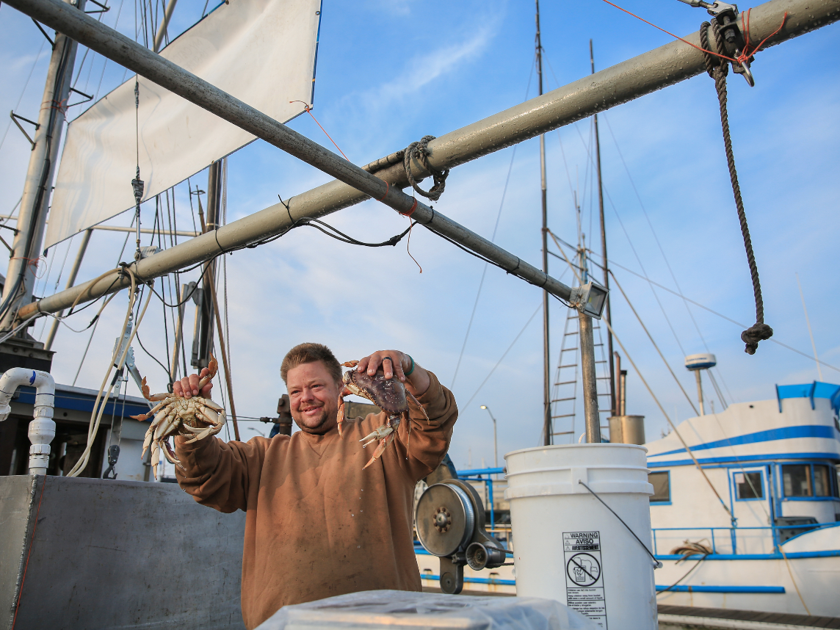Dungeness crab fishermen are sitting out the first days of the already-delayed season after they failed to settle on a price for their catch.
Every year, the days leading up to the opening of the commercial crab season are filled with negotiations with wholesale distributors. Knowing the price buyers will pay per pound offers fishermen assurance that their efforts will be worthwhile by the time they haul in their catch.
But fishermen at Pillar Point Harbor are calling the price offered to date simply unacceptable.
The commercial Dungeness crab season officially opened on Dec. 23, but after the Half Moon Bay Seafood Marketing Association — the negotiator for the San Mateo County fleet — failed to reach a settlement with several wholesalers, fishermen decided they would rather sit back a few days than risk a loss from a low fixed price.
The fishing operations at the Pillar Point Harbor vary. The Coastside has attracted a growing base of individual customers and local fish markets that buy directly off the boats. But many fishermen rely heavily and, in some cases, exclusively on sales to wholesalers that distribute locally caught crab throughout the country and outside the United States.
Several fishermen interviewed said one distributor in particular, Pacific Choice Seafoods Co., based in Eureka, seems to dictate the price. During this year’s negotiations, Pacific Choice offered between $2.25 and $2.30 per pound. Though board members of the Half Moon Bay fishermen’s association were reluctant to state a reasonable price so as not to jeopardize negotiations, some fishermen said a reasonable price would begin at $3 per pound to cover the cost of fuel, maintenance and labor.
Jon Steinman, vice president of processing for Pacific Seafood, Pacific Choice Seafoods Company’s parent company, pushed back against the idea the company is pushing fishermen into a corner.
“The notion that Pacific Seafood is holding up the Dungeness season is absurd,” Steinman said. “We are one of many other major buyers on the West Coast. We have to do the best we can for our customers, our fishermen and our team members who are counting on us to run a good business and be here for this season and years to come.”
A spokesperson for the company said COVID-19 has negatively impacted processors like Pacific Seafood. Demand for seafood dropped more than 70 percent, leaving processing plants with an excess of seafood products. In addition to reduced demand related to the troubled restaurant industry, the pandemic’s restrictions created labor shortages and increased production costs. All of that influences the company’s asking price, wholesalers say.
The initial offer came as a blow to fishermen who said they are already suffering financially after two delays to the start of the season and what was a shortened season last year. Frank Sousa, commercial fisher on the “Bev A,” said he expects revenue to be down 30 percent from the shortened season alone.
Sousa sells to another wholesaler, but he said “everybody seems to just fall in place behind them after (Pacific Choice) negotiations happen.”
“In the past, they’ve seemed to predominantly have the most pull on what the price should be,” he said.
The battle over wholesale crab prices isn’t a new phenomenon and fishermen said they go through some version of it every year. But Sousa said this year feels particularly bad, especially for fishermen who saw slashed sales for other types of seafood during the pandemic. They were looking to the Dungeness crab season as a financial brightspot.
In the past, the standoff over wholesale price used to create tension between large volume vessels and smaller boats that almost exclusively sell directly to local buyers, many of whom fishermen said are willing to pay them their asking price. But over the years, these direct-to-consumer fishers have seen the importance of standing together.
Rob Kraencke, captain of the “Lady LeBlanc,” is one fisherman who doesn’t deal with wholesalers. Though he said he could have started fishing when the season opened, he decided against it.
“I fish against bigger boats with younger crews that are willing to put in more hours than I am, and I don’t hold it against those guys. We do our work in a different manner, but it wouldn’t be right to go out when others are standing down,” Kraencke said.
If the matter had been settled on time, a mass of vessels would have been out dropping gear into the water at 6 a.m. on Dec. 22 so that they could begin reeling in their catch on Dec. 23. Instead, boats were docked and crab pots sat stacked in the Pillar Point Harbor parking lot.
When the season officially opened, Kraencke walked through the parking lot, checking up on his gear. For his part, Sousa decided to go on a hike.
“The only good thing I see coming out of this is that we’re able to spend Christmas with our families,” Sousa said.
But he remains optimistic that when talks resume after the holidays, the fishermen and wholesalers can agree on a reasonable price in time for a healthy demand on New Year’s Day.


